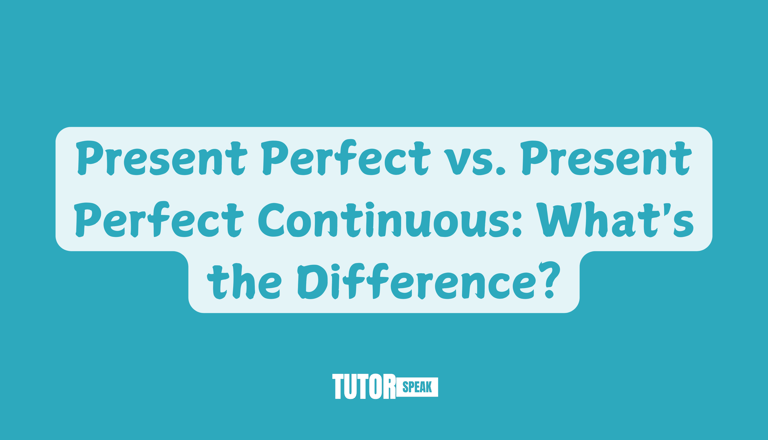Present Perfect vs. Present Perfect Continuous: What's the Difference?
The Present Perfect and Present Perfect Continuous tenses are commonly confused because both refer to actions that connect the past and the present. However, they have different meanings, structures, and uses. In this article, we will explain the differences, provide examples, highlight common mistakes with corrections, and give exercises to help you master these tenses.
TutorSpeak
3 min read


Present Perfect vs. Present Perfect Continuous: What's the Difference?
The Present Perfect and Present Perfect Continuous tenses are commonly confused because both refer to actions that connect the past and the present. However, they have different meanings, structures, and uses. In this article, we will explain the differences, provide examples, highlight common mistakes with corrections, and give exercises to help you master these tenses.
What Is the Present Perfect Tense?
The Present Perfect tense is used to describe actions that:
Happened at an unspecified time in the past but still have relevance to the present.
Started in the past and continue into the present (often with "since" or "for").
Describe life experiences (without mentioning a specific time).
Structure:
Subject + have/has + past participle (V3)
Examples:
I have finished my work. (The action is completed, and the result is relevant now.)
She has lived in New York since 2015. (The action started in the past and continues.)
They have visited Japan three times. (Describes life experience.)
Common time expressions: ever, never, already, yet, just, since, for, so far, up to now, recently.
What Is the Present Perfect Continuous Tense?
The Present Perfect Continuous tense emphasizes the duration of an action that:
Started in the past and is still happening now.
Recently stopped, but the effects are still visible.
Structure:
Subject + have/has been + verb-ing
Examples:
I have been working here for five years. (The action started in the past and is still continuing.)
She has been running, so she is out of breath. (The action recently stopped, but we can see the effect.)
They have been studying all morning. (Emphasizes the duration of the action.)
Common time expressions: for, since, all day, all morning, lately, recently.
Key Differences Between Present Perfect and Present Perfect Continuous
Focus on result vs. duration
Present Perfect focuses on the completion or result of an action.
Present Perfect Continuous focuses on how long the action has been happening.
Action completed vs. still continuing
Present Perfect is used when the action is completed.
Present Perfect Continuous is used when the action is still happening or just finished.
Stative verbs
The Present Perfect Continuous is not used with stative verbs (e.g., know, like, want, be, own). Instead, the Present Perfect is used.
❌ I have been knowing him for years.
✅ I have known him for years.
Common Mistakes:
1. Using Present Perfect Continuous with Stative Verbs
❌ She has been knowing the answer since yesterday.
✅ She has known the answer since yesterday.
Explanation: "Know" is a stative verb and does not take the continuous form.
2. Using Present Perfect Instead of Present Perfect Continuous for Ongoing Actions
❌ I have worked here for five years.
✅ I have been working here for five years.
Explanation: Since the action is ongoing, we use Present Perfect Continuous.
3. Using Present Perfect Continuous for Completed Actions
❌ I have been finishing my homework.
✅ I have finished my homework.
Explanation: "Finished" is a completed action, so we use Present Perfect.
4. Using Present Perfect for Temporary Actions
❌ She has lived in Paris for a few weeks.
✅ She has been living in Paris for a few weeks.
Explanation: If the action is temporary, Present Perfect Continuous is preferred.
Exercises:
Exercise 1: Fill in the blanks with the correct form of the verb.
She _________ (work) at this company since 2010.
We _________ (wait) for you for over an hour!
He _________ (read) this book three times.
I _________ (study) all morning, and now I need a break.
They _________ (paint) the house for two weeks.
Exercise 2: Correct the mistakes in the following sentences.
I have been knowing him for five years.
She has finished the project since last Monday.
He has been buying a new car.
They have waited for the bus for 30 minutes.
I have been seeing that movie already.
Exercise 3: Choose the correct option.
I __________ (have completed / have been completing) my homework, so I can go out now.
She __________ (has worked / has been working) on this report all day.
They __________ (have visited / have been visiting) Rome three times.
He __________ (has been learning / has learned) English for two years.
We __________ (have been cleaning / have cleaned) the house, and now it looks great!
Exercise 4: Write sentences using the following prompts.
I / study / French / since last year.
She / write / emails / all morning.
They / travel / to many countries.
He / live / in this apartment / for two months.
We / work / on the project / for weeks.



